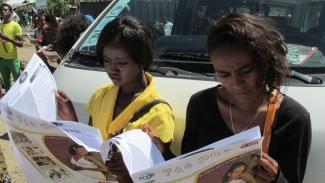Contraception
Facts and figures on family planning
 DSW
DSW
The number of women in developing countries who use contraception rose from 510 million in 2003 to 671 million in 2017. This is an increase of about 30 percent and looks like a great success at first glance.
But the contraceptive needs of a lot of women (15 to 49 years old) are not being met. They want to avoid pregnancies, but are denied modern methods. Up-to-date contraceptives include intrauterine devices (IUDs), pills, male and female condoms as well as quarterly injections. Traditional methods such as coitus interruptus and menstrual rhythm methods are too unreliable to be considered modern.
Unfortunately, the percentage of women whose contraceptive needs are not being met has not changed much because the number of women who want modern contraceptives in developing countries has risen from 720 million in 2003 to 885 million in 2017. That was an increase of over 20 %. Three quarters of this increase can be attributed to population growth alone. Of course, education and the increasing emancipation of women contribute to more women wanting to use modern contraceptives too.
The largest demographic share of women whose family planning needs are not being met are those between the ages of 15 and 19 (60 % unmet), in comparison to the overall percentage of women between 15 and 49 (26 % unmet). The lack of access to contraceptives is one reason almost 21 million adolescent girls in developing countries become pregnant every year – about half of them unplanned. Seventeen thousand of them die because of complications in the pregnancy or during birth. This is the number one cause of death for girls between the ages of 15 and 19. In 2017, the cost for modern contraceptive services for 671 million users in developing countries amount to $ 5,5 billion. This estimate includes the costs of contraceptive devices, health-worker salaries and programme and system costs. If the 214 million women who lack access to family planning were to have their needs fulfilled, the total cost would rise to an annual $ 11 billion.
